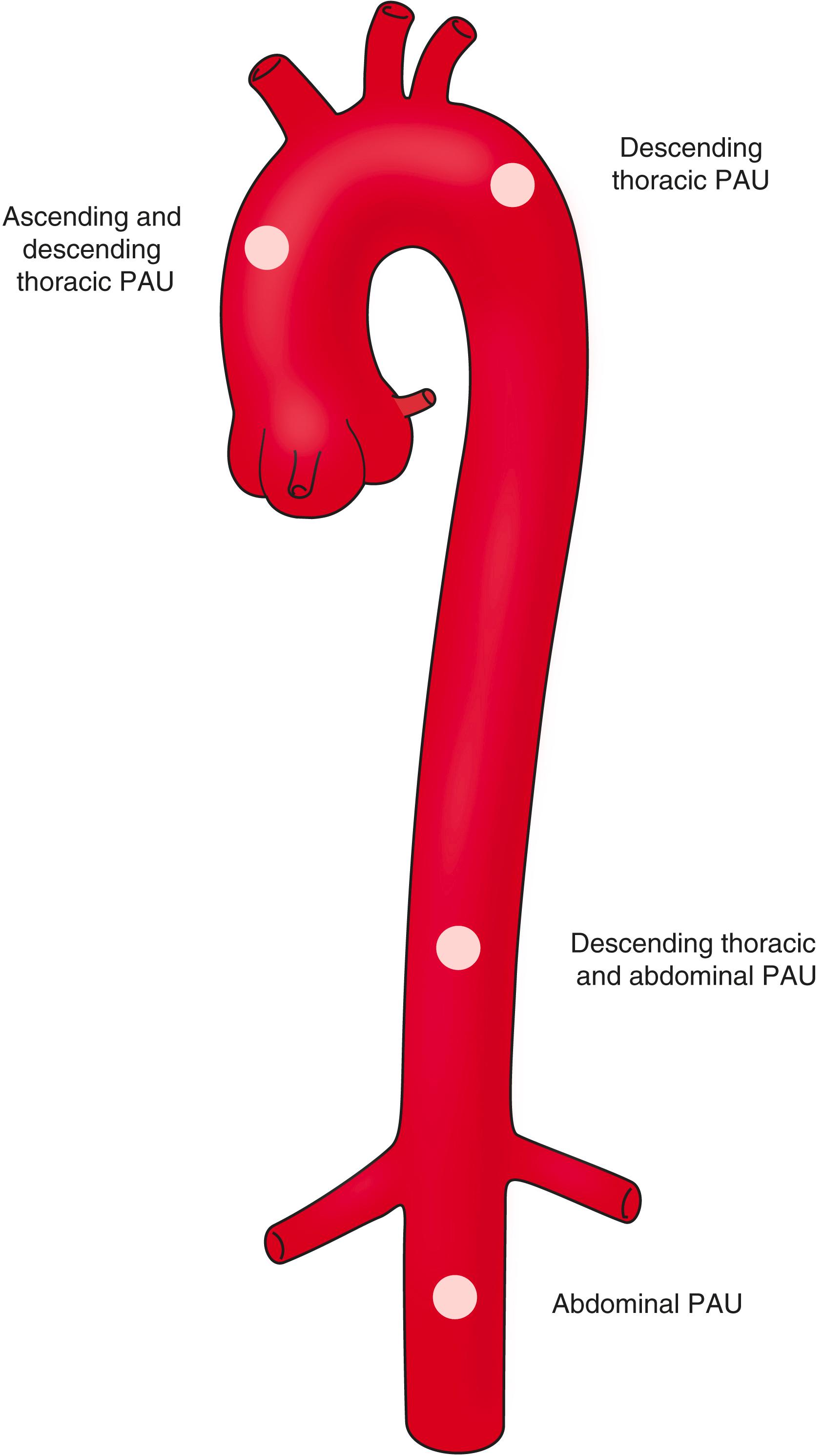Physical Address
304 North Cardinal St.
Dorchester Center, MA 02124
The presence of a penetrating aortic ulcer (PAU) often indicates a severely diseased aorta. Although first described as an incidental component of dissecting aneurysms in 1934, PAU was not clearly defined as an aortic pathology until 1986 and is now considered a subset of the acute aortic syndrome (AAS). , AAS entails three distinct, albeit related, pathologies – acute aortic dissection (AD), intramural hematoma (IMH), and PAU. PAU is the least common of the three, affecting only 2%–3% of the population. Given that they are relatively uncommon, the principles of PAU management have been based on outcomes from more than 20 years of retrospective case series. Currently, PAUs are more easily identified on imaging and treatment strategies for symptomatic lesions have improved outcomes.
A PAU is a focal ulcerative lesion that develops in the region of an atheromatous plaque that penetrates the internal elastic lamina of the vascular wall. Shennan was the first to describe a PAU, but it was not described as a distinct lesion distinguished from other aortic pathologies until Stanson’s report in 1986. , PAUs typically occur in an area of significant aortic atheroma, but not all PAU are associated with atherosclerosis. Only 53% of PAUs identified on imaging were associated with atherosclerotic lesions. The ulcer can be circumferential or longitudinal. PAUs can evolve such that they disrupt the aortic media creating IMH or they can even disrupt the adventitia forming a pseudoaneurysm. In fact, up to 80% of PAUs may have associated IMH within the medial layer of the aortic wall, although the hematoma extent is typically confined by surrounding calcific disease. It is important, however, to distinguish patients who have isolated PAU versus PAU with IMH as the latter may have a worse prognosis, a propensity to progress to AD, and an obstacle for endovascular treatment.
Traumatic injury to the aortic wall is not considered to be contributory to the development of PAUs. Unlike AD, PAUs do not necessarily occur at points of maximal hydraulic stress, such as the right lateral wall of the ascending aorta or at the ligamentum arteriosum in the descending thoracic aorta. In addition, PAUs do not occur more often in patients with genetic mutations associated with AD, such as Marfan syndrome, cystic media necrosis, or seronegative spondyloarthropathies.
Histologic analysis of PAUs is somewhat sparse since most lesions are treated with conservative medical management or endovascular therapy and thus the ability to obtain aortic tissue is limited. However, macrophages are often seen in the vascular media of PAUs along with inflammatory markers like matrix metalloproteinases. Both PAU and IMH demonstrate cells undergoing apoptosis along with degeneration of the vasovasorum.
PAUs, despite a similar appearance, are separate entities from pseudoaneurysms, as well as saccular and mycotic aneurysms. As mentioned above, PAUs can degenerate into pseudoaneurysms or saccular aneurysms with adventitial expansion beyond the original borders of the aortic wall. In fact, nearly 25% of abdominal and thoracic PAUs degenerate into saccular aneurysm. Mycotic aneurysms can also have an ulcerated appearance on imaging; however, there is an associated systemic inflammatory response (fevers, leukocytosis, tachypnea, and/or tachycardia, etc.). Characteristic radiographic findings of a mycotic aneurysm include surrounding inflammation with stranding representing infected fluid or tissue. Patients presenting with such symptoms or radiographic findings should have blood cultures drawn, broad-spectrum antibiotics started, and definitive surgical repair as appropriate.
Only 2%–8% of patients with AAS have a PAU, with the absolute majority of these lesions located in the descending thoracic aorta. , In 120 patients undergoing transesophageal echocardiogram to assess suspected AAS, only 2.5% of the cohort had a PAU, whereas 37.5% of patients had AD. In a review of 684 consecutive aortograms for suspected AD, the occurrence of PAU was similarly 2.3%. Coady et al. noted a higher incidence of PAU of 7.6% when reviewing 198 patients with initial diagnosis of AD. However, the true incidence of PAU is unknown as there is certainly a proportion that remain asymptomatic and thus unidentified. The incidence is likely to increase with time as the utilization of high-resolution cross-sectional imaging expands.
PAUs typically affect elderly men in their 7th and 8th decades of life. , , In a broad review of the literature, the mean age of patients with PAU was 71.9 ± 6.1 years, which is in distinction to patients with AD who typically present a decade or two earlier (mean age, 63 years). , Similar to AD, about two-thirds of those with PAU are men. , One retrospective review identified female gender to be associated with worse outcomes. However, a larger series by Czerny and colleagues reported no difference in the 1- and 5-year survival after TEVAR for PAU between genders. Similar to AD and IMH, almost all patients with PAU suffer from hypertension. Other common comorbidities include smoking history, coronary artery disease, and chronic obstructive pulmonary disease. , Notably, the incidence of concomitant abdominal aortic aneurysms has been reported to be as high as 50% in patients with PAUs, which is not the case in those with acute AD. , ,
PAUs can occur anywhere along the aorta and into the femoral arteries; however, most are located in the descending thoracic aorta followed by the aortic arch and thoracoabdominal aorta. PAUs in the ascending aorta are infrequent , , ( Fig. 84.1 ). PAUs within the infrarenal aorta and iliofemoral segments are uncommon with an incidence of only 4%. , PAUs are often single, isolated lesions, but 17%–22% of patients present with multiple PAUs.

Become a Clinical Tree membership for Full access and enjoy Unlimited articles
If you are a member. Log in here